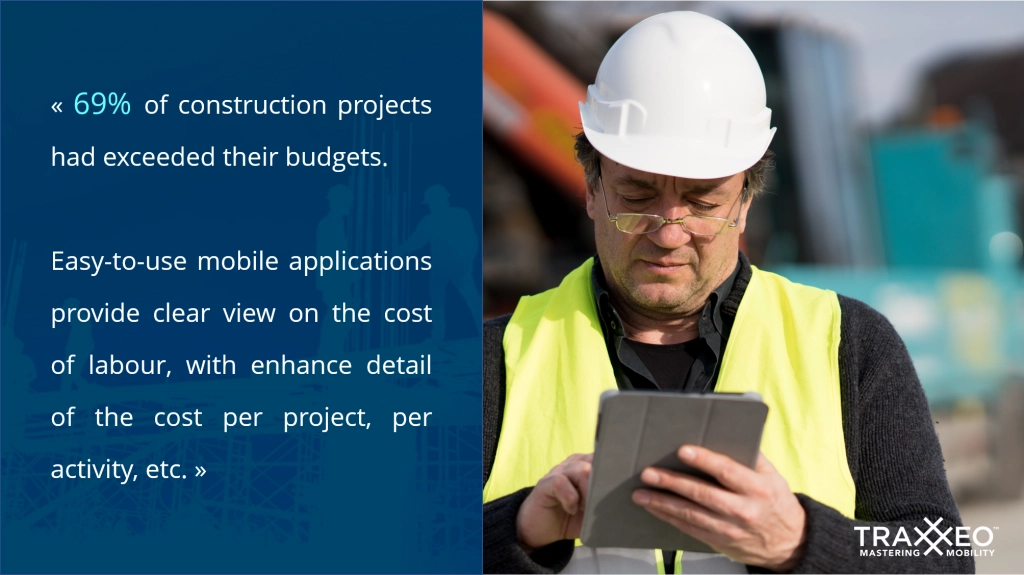Monitor the budget of your work site with real-time cost controlling

Managing the financial budget of a worksite has always been full of challenges. But modern digital tools now mean that it has never been easier to gather qualitative information in real-time from your workers. By working in this way, the reactivity of the finance department increases and you can obtain a great insight into the real cost per activity on a worksite.
Construction and infrastructure companies can often struggle to closely control the financial aspect of a worksite. As an example, in the UK in 2015 it was found that 69% of construction projects had exceeded their budgets. One of the reasons for this difficulty is because there are so many different costs involved. Keeping track of labour costs is especially difficult because the workforce performs numerous tasks throughout the day without sending you an invoice at the end of it (unlike what happens with subcontractors and materials).
What makes cost control so important?
There are four elements that make it vitally important to follow costs closely:
- The construction sector is very competitive indeed, which puts pressure on margins. You need to keep your costs under control to be profitable.
- There are many budget overruns on big construction projects. The sooner you detect a potential overrun, the sooner you can avoid or reduce it.
- Complex cooperation between construction firms requires deep insight into ways of working in order to hold a strong negotiating position.
- Human labour is expensive. Reducing this cost – even by just a little – has a huge impact on profitability.
It’s clear that construction companies need a clear view on the cost of labour, ideally with enhanced detail of the cost per project and per activity performed on-site. Until recently, those responsible for following the budget of a worksite were limited to using just a few different methods to obtain this information, such as:
- Some companies only perform an analysis after the project is completed. However, by then, much information has been lost and the project could have been loss-making without them even knowing it at the time. Therefore, they are doomed to making the same mistake over and over again.
- Other companies have a paper-based process in place to gather information from workers. But this carries a heavy administrative burden for both the workers and HQ – for example, all of the activities carried out and the hours spent are written down, which then goes through a validation process before being entered into a software program (often multiple times). The insights only arrive 3–4 weeks after the facts, which greatly reduces reactivity.
- A modern track and trace solution is great for monitoring your assets and automating payroll, but it is often a ‘black box’ for finance as it doesn’t give any information on what exactly has been done during the time on-site.
In summary, the gathering of information for effective cost control either carries a heavy administration burden for everyone involved, resulting in a long processing time and reduced reactivity, or it is not done properly and as such it doesn’t deliver the expected value to the company.

Moving forward with digital solutions
The good news, though, is that technology has evolved hugely over recent years and we’re now seeing much more use of smartphones and tablets everywhere – even on worksites. So, why not use the same tool that makes our personal life so much easier in our professional life, too?
Easy-to-use mobile applications have been developed that allow workers to quickly and easily input crucial information, which is then available in real-time for any business purpose. There are numerous advantages to the use of a mobile application, including:
- You don’t need to invest in expensive hardware. Almost everybody in the workplace has a smartphone or tablet.
- The whole data gathering process becomes automated from the worksite onwards. No manual entry is necessary anywhere else.
- The data is qualitative, using drop-down lists and icons with a standardised process, creating insights at an organisational level.
- The data is immediately available, enabling the finance department to intervene and follow-up quickly where necessary.
- The data is also usable by other departments, such as HR for automating the payroll process.
- Deep insights into the ways of working across all the worksites will enable the company to make better and more precise bids for new work in the future, ensuring profitability.
An increasing number of construction companies are exploiting these tools to enjoy the benefits and to attract skilled, young workers who want to use these familiar tools in their professional life. Using mobile applications on a worksite can significantly help to safeguard the future prosperity of a construction company.
The writing seems to be on the wall for the old ways of working, as they are being superseded by the use of digital solutions. Bringing your worksite into the 21st century with the tools that are available today will go a long way towards making your company smart, efficient and future-ready!
Other content that might interest you

Financial management of construction projects: cost management best practices for…
Financial management of a worksite is at the heart of the success of a construction project. Along with meeting deadlines,…

The 6 trends to watch for in the construction industry…
From new construction modes to continuous inflation, which trends are going to shape the construction industry in 2023? While the…

Fleet management software: get the best out of your vehicles…
Being a fleet manager is definitely complicated. There are a lot of factors in play that all have to be…
Join more than 10,000 experts
Sign up to receive our most popular resources as well as other premium content to help you become more productive and profitable.